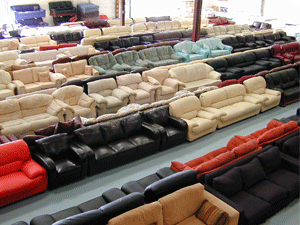The U.S. Furniture Industry
- Written by Admin TOA
- Published in Industries
By Al Schuler & Steve Lawser
In the United States, furniture and related manufacturing (including kitchen cabinets) is currently concentrated in three geographic locations: the Midwest (Michigan, Indiana, Ohio, Wisconsin, Illinois), the South (North Carolina, Mississippi, Virginia) and the Southwest (California, New Mexico, Texas).
Today, the top 12 producing states manufacture about two-thirds of the furniture and kitchen cabinets produced in the United States.
There is a growing dichotomy in the "furniture industry." The furniture industry, excluding the kitchen cabinet sector, lost 108,000 jobs or 21 percent of its workforce between 1997 and 2005. Only two sectors within the U.S. furniture industry - kitchen cabinets and office furniture - have shown growth in terms of employees, payroll and value of shipments.
For example, between 1997 and 2005*, the value of shipments for kitchen cabinets more than doubled (up 111 percent), office furniture shipments increased 22 percent, upholstered furniture shipments increased a modest 27 percent; institutional furniture shipments increased a meager 9 percent while shipments of nonupholstered furniture (i.e., wood furniture) actually fell 7 percent. The reason for this disparity is competition from cheaper imports has impacted the household furniture sector, particularly wood household furniture.
In essence, imported wood furniture from Canada and offshore sources, particularly China, captured most of the growth in the wood furniture market during the past seven years. Demand was driven in large part by the phenomenal growth in residential construction over this period, but domestic manufacturers did not share in the "good times."

LESS SPENDING ON FURNITURE
Consumers are mainly interested in furniture that looks good and appears to be a good value. No longer do they look at furniture as a long-term investment as something to pass on to their children or keep as an antique. As a result, the consumer is spending less and less on furniture. There is also more competition for the consumer's dollar from electronic gadgets, home entertainment, travel and leisure products. Because of this emphasis on price, profit margins for U.S. furniture manufacturers are extremely low, while the costs of manufacturing continue to rise. This has created a severe profit squeeze that has led to a significant decline in plant and equipment investments. As a result, many U.S. furniture plants are not up-to-date with the latest technology and equipment.
Many U.S. furniture manufacturers are choosing to have their furniture made in China and other low-cost countries rather than produce their own products. This has allowed offshore furniture competitors to increase their penetration into United States and world markets. If this does not change, most U.S. household furniture will be made offshore as U.S. furniture manufacturers continue to close their domestic manufacturing operations and become wholesalers and/or retailers. As offshore manufacturers gain more experience from supplying U.S. furniture manufacturers, they will learn enough to go around them and sell direct to retailers, or through their own retail distribution outlets. This is already happening as most of the larger Chinese furniture manufacturers sell direct to retailers and some are offering retail franchises in the United States.
THE IMPACTS OF GLOBALIZATION
Globalization impacted trade in the furniture subsector has taken a distinct turn for the worse for U.S. manufacturers, with the kitchen cabinet industry group more recently experiencing the beginning of a downturn in growth as well. Between 1992 and 2005, imports of all furniture products (including household, institutional and office furniture, but excluding kitchen cabinets) increased from $4.1 billion to $23.65 billion in 2005, an increase of almost $20 billion or 477 percent. During this period, imports from China increased from $208 million to $10.8 billion, an increase of almost $11 billion - a fifty-fold increase in 13 years.
Imports now comprise 28 percent of all furniture consumption (excluding kitchen cabinets), up from 9 percent 13 years ago. In sectors where wood is the predominant material input, the loss of market share is equal, or in some cases, more substantial. Fifty-five percent of the wood household furniture, 11 percent of kitchen cabinets; 19 percent of the upholstered market; and 21 percent of the wood office furniture market consumed in the United States in 2005 consisted of imports.
Since the wood household furniture sector has been the most ravaged by imports, the major sources of imports is China. Chinese imports have increased 525 percent since 1998 - that's more than a six-fold increase in just eight years. A major reason for this rapid increase is that the Taiwanese furniture industry, with its management expertise, capital, knowledge of the U.S. market, and other pertinent expertise, relocated to mainland China beginning in the early 1990s.

IMPORT TRENDS
Taiwan was a major manufacturer and exporter of wood furniture to the United States; however, as their standard of living increased, their furniture manufacturing costs, particularly the labor component, increased significantly and they were no longer as competitive as they once were. Thus, a "manufacturing capacity migration" is occurring in East and Southeast Asia from Taiwan (and to some extent mainland China) to Vietnam.
Wood furniture exports to the United States from Vietnam have increased from $1 million to $753 million in just five years. In fact, Vietnam is now the third largest exporter of wood household furniture to the United States, behind China and Canada - predictions point to it surpassing Canada within five years.
The common denominator for most of these industries is too much focus on production and not enough attention paid to the customer - i.e., a commodity mentality. Not a good strategy unless you are the "low-cost producer" or have some other competitive advantages that serve to balance the scales for companies that have a higher cost structure. Some examples include: superior service; customization at competitive prices; faster delivery; better credit terms; lean and flexible manufacturing; expert marketing and knowledge of your key customers; and superior quality.
* Al Schuler is a research economist with the USDA Forest Service. /
* Steve Lawser serves as the executive director of the Wood Components Manufacturers Association (WCMA).
KUTU
ORGANIZATIONS
WOOD COMPONENT MANUFACTURERS ASSOCIATIONS
Address: 741 Butlers Gate, Suite 100 Marietta, Georgia 30068
Telephone: +1 (770) 565-6660 Fax: +1 (770) 565-6663
E-mail address: This email address is being protected from spambots. You need JavaScript enabled to view it.
Web: www.woodcomponents.org
HOME FURNISHINGS INDEPENDENTS ASSOCIATION
Address: P.O Box 420807, Dallas, TX 75342
Tel: +1 (214) 741 7632 Fax: +1 (214) 742 9103
E-mail: This email address is being protected from spambots. You need JavaScript enabled to view it.
WESTERN HOME FURNISHINGS ASSOCIATIONS
Address: 500 Giuseppe Court, Suite 6 Roseville, CA 95678
Tel: +1 (916) 784-7677 Fax: +1 (916) 784-7697
E-Mail: This email address is being protected from spambots. You need JavaScript enabled to view it.
Web: www.whfa.org
NATIONAL HOME FURNISHINGS ASSOCIATION
Address: 3910 Tinsley Drive, Suite 101 High Point, NC 27265
Tel: +1 (800) 888-9590 Fax: +1 (336) 801-6102
E-mail: This email address is being protected from spambots. You need JavaScript enabled to view it.
Web: www.nhfa.org
Latest from Admin TOA
- Fat Sal’s Italian Specialties Welcomes Customers in Bayville, NJ with a Renewed Concept
- FFD Wood LLC Delivers Custom Woodwork Solutions from Long Island
- A Tax Expert in the U.S. Tax World: An Interview with Samet Oynamıs
- Announcing the 2025 Edition of the 100 Most Influential Turkish Americans
- CEO Club New York Networking Night Stands Out with the Lamborghini Experience









